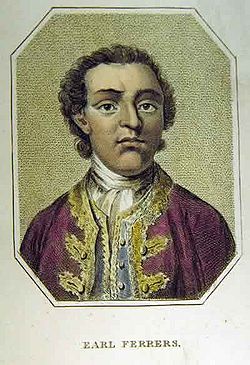| Earl Ferrers | |
|---|---|
  Arms of Shirley, Earls Ferrers: Paly of six, or and azure, a canton ermine. [1] | |
| Creation date | 1711 |
| Created by | Anne |
| Peerage | Great Britain |
| First holder | Robert Shirley, 1st Earl Ferrers |
| Present holder | Robert Shirley, 14th Earl Ferrers |
| Heir apparent | William Shirley, Viscount Tamworth |
| Subsidiary titles | Viscount Tamworth Baronet Shirley of Staunton |
| Seat | Ditchingham Hall |
| Motto | Honor vertutus premium (Honour is the reward of valour) [2] |

Earl Ferrers is a title in the Peerage of Great Britain. It was created in 1711 for Robert Shirley, 14th Baron Ferrers of Chartley. The Shirley family descends from George Shirley (died 1622) of Astwell Castle, Northamptonshire. In 1611 he was created a Baronet, of Staunton Harold in the County of Leicester, in the Baronetage of England. He was succeeded by his son Henry, the second Baronet, who married Lady Dorothy Devereux, daughter of Robert Devereux, 2nd Earl of Essex. On the death of her brother Robert Devereux, 3rd Earl of Essex, she became the youngest co-heir to the baronies of Ferrers of Chartley and the barony of Bourchier, which had fallen into abeyance on the death of the third Earl. Shirley was succeeded by his eldest son, the third Baronet. He died unmarried and was succeeded by his younger brother, the fourth Baronet. He was imprisoned in the Tower of London by Oliver Cromwell and died there in 1656. On his death the title passed to his eldest son, the fifth Baronet. He died at an early age and was succeeded at birth by his posthumous son, the sixth Baronet. [3]
Contents
- Shirley baronets, of Staunton Harold (1611)
- Earls Ferrers (1711)
- Present peer
- Notes
- References
- External links
He died as an infant and was succeeded by his uncle, the seventh Baronet. In 1677 King Charles II terminated the abeyance of the Ferrers of Chartley barony in his favour and he became the thirteenth Baron. His claim to the Bourchier barony was overlooked, however. He later served as Master of the Horse and as Lord Steward to the queen consort, Catherine of Braganza, and was Lord Lieutenant of Staffordshire. In 1711 he was created Viscount Tamworth, of Tamworth in the County of Stafford, and Earl Ferrers, in the Peerage of Great Britain. He was succeeded in the barony of Ferrers of Chartley by his granddaughter Elizabeth, wife of James Compton, 5th Earl of Northampton. She was the daughter of the first Earl's eldest son the Hon. Robert Shirley (1673–1698), who predeceased his father (see the Baron Ferrers of Chartley for further history of this title). Lord Ferrers was succeeded in the baronetcy, viscountcy and earldom by his second son, the second Earl. He served as Lord Lieutenant of Staffordshire from 1725 to 1729. He died childless and was succeeded by his younger brother, the third Earl. He was Lord Lieutenant of Staffordshire from 1731 to 1742.
He died unmarried and was succeeded by his nephew, the fourth Earl. He was the son of the Hon. Lawrence Shirley, third surviving son of the first Earl. Lord Ferrers killed Mr. Johnson, his land-steward, was tried, condemned for murder and hanged at Tyburn on 5 May 1760. Ferrers petitioned to be beheaded at the Tower of London as had been the case with noble lords before him. [4] He is the last British peer to die a felon's death. On his death the titles passed to his younger brother, the fifth Earl. He was a vice-admiral in the Royal Navy. He was childless and was succeeded by his younger brother, the sixth Earl. His eldest son, the seventh Earl, died childless and was succeeded by his younger brother, the eighth Earl. When the latter died the titles passed to his grandson, the ninth Earl. He was the son of Robert William Shirley, Viscount Tamworth, eldest son of the eighth Earl. He was succeeded by his son, the tenth Earl. On his death in 1912 the line of the sixth Earl failed. The late Earl was succeeded by his third cousin, the eleventh Earl. He was the great-great-grandson of Reverend the Hon. Walter Shirley, brother of the fourth, fifth and sixth Earls. As of 2010 [update] the titles were held by his grandson, the thirteenth Earl, who succeeded his father in 1954 until death in 2012. Lord Ferrers was a prominent Conservative politician and held office in every Conservative administration from 1962 to 1997. He was one of the ninety elected hereditary peers that remain in the House of Lords after the passing of the House of Lords Act 1999. As of 2014 the titles are held by his elder son, the fourteenth Earl, who succeeded in 2012.
The Ferrers earldom is the senior earldom in the Peerage of Great Britain.
The family seat is Ditchingham Hall, near Ditchingham, Norfolk.


